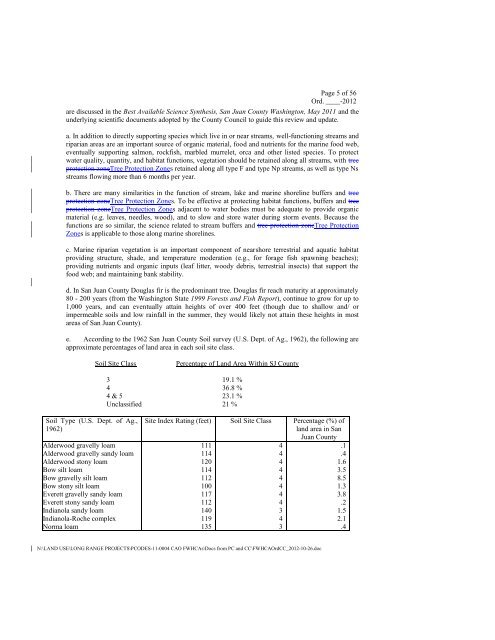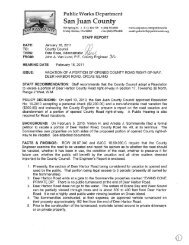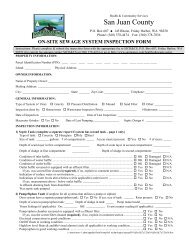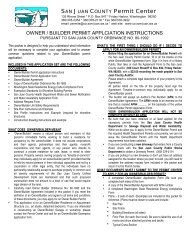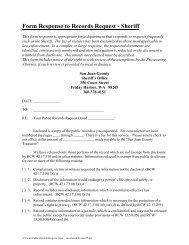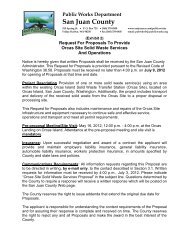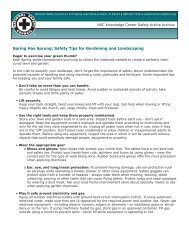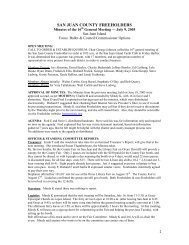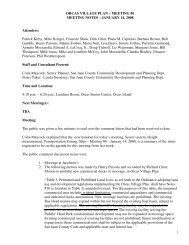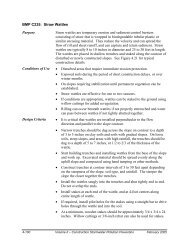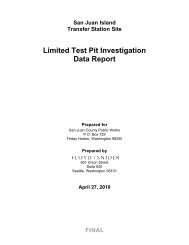Ordinance No._____- 2012 AN ORDINANCE ... - San Juan County
Ordinance No._____- 2012 AN ORDINANCE ... - San Juan County
Ordinance No._____- 2012 AN ORDINANCE ... - San Juan County
You also want an ePaper? Increase the reach of your titles
YUMPU automatically turns print PDFs into web optimized ePapers that Google loves.
Page 5 of 56<br />
Ord. ____-<strong>2012</strong><br />
are discussed in the Best Available Science Synthesis, <strong>San</strong> <strong>Juan</strong> <strong>County</strong> Washington, May 2011 and the<br />
underlying scientific documents adopted by the <strong>County</strong> Council to guide this review and update.<br />
a. In addition to directly supporting species which live in or near streams, well-functioning streams and<br />
riparian areas are an important source of organic material, food and nutrients for the marine food web,<br />
eventually supporting salmon, rockfish, marbled murrelet, orca and other listed species. To protect<br />
water quality, quantity, and habitat functions, vegetation should be retained along all streams, with tree<br />
protection zoneTree Protection Zones retained along all type F and type Np streams, as well as type Ns<br />
streams flowing more than 6 months per year.<br />
b. There are many similarities in the function of stream, lake and marine shoreline buffers and tree<br />
protection zoneTree Protection Zones. To be effective at protecting habitat functions, buffers and tree<br />
protection zoneTree Protection Zones adjacent to water bodies must be adequate to provide organic<br />
material (e.g. leaves, needles, wood), and to slow and store water during storm events. Because the<br />
functions are so similar, the science related to stream buffers and tree protection zoneTree Protection<br />
Zones is applicable to those along marine shorelines.<br />
c. Marine riparian vegetation is an important component of nearshore terrestrial and aquatic habitat<br />
providing structure, shade, and temperature moderation (e.g., for forage fish spawning beaches);<br />
providing nutrients and organic inputs (leaf litter, woody debris, terrestrial insects) that support the<br />
food web; and maintaining bank stability.<br />
d. In <strong>San</strong> <strong>Juan</strong> <strong>County</strong> Douglas fir is the predominant tree. Douglas fir reach maturity at approximately<br />
80 - 200 years (from the Washington State 1999 Forests and Fish Report), continue to grow for up to<br />
1,000 years, and can eventually attain heights of over 400 feet (though due to shallow and/ or<br />
impermeable soils and low rainfall in the summer, they would likely not attain these heights in most<br />
areas of <strong>San</strong> <strong>Juan</strong> <strong>County</strong>).<br />
e. According to the 1962 <strong>San</strong> <strong>Juan</strong> <strong>County</strong> Soil survey (U.S. Dept. of Ag., 1962), the following are<br />
approximate percentages of land area in each soil site class.<br />
Soil Site Class<br />
Percentage of Land Area Within SJ <strong>County</strong><br />
3 19.1 %<br />
4 36.8 %<br />
4 & 5 23.1 %<br />
Unclassified 21 %<br />
Soil Type (U.S. Dept. of Ag.,<br />
1962)<br />
Alderwood gravelly loam<br />
Alderwood gravelly sandy loam<br />
Alderwood stony loam<br />
Bow silt loam<br />
Bow gravelly silt loam<br />
Bow stony silt loam<br />
Everett gravelly sandy loam<br />
Everett stony sandy loam<br />
Indianola sandy loam<br />
Indianola-Roche complex<br />
<strong>No</strong>rma loam<br />
Site Index Rating (feet) Soil Site Class Percentage (%) of<br />
land area in <strong>San</strong><br />
<strong>Juan</strong> <strong>County</strong><br />
111<br />
114<br />
120<br />
114<br />
112<br />
100<br />
117<br />
112<br />
140<br />
119<br />
135<br />
4<br />
4<br />
4<br />
4<br />
4<br />
4<br />
4<br />
4<br />
3<br />
4<br />
3<br />
.1<br />
.4<br />
1.6<br />
3.5<br />
8.5<br />
1.3<br />
3.8<br />
.2<br />
1.5<br />
2.1<br />
.4<br />
N:\L<strong>AN</strong>D USE\LONG R<strong>AN</strong>GE PROJECTS\PCODES-11-0004 CAO FWHCAs\Docs from PC and CC\FWHCAOrdCC_<strong>2012</strong>-10-26.doc


